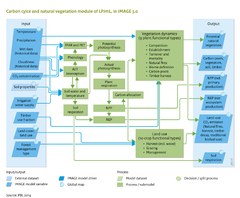Carbon cycle and natural vegetation: Difference between revisions
Jump to navigation
Jump to search
No edit summary |
No edit summary |
||
| Line 1: | Line 1: | ||
{{ComponentTemplate2 | {{ComponentTemplate2 | ||
|IMAGEComponent=Carbon, vegetation, agriculture and water; Atmospheric composition and climate | |IMAGEComponent=Carbon, vegetation, agriculture and water; Agriculture and land use; Atmospheric composition and climate; Terrestrial biodiversity; Ecosystem services; Land cover and land use; | ||
|ExternalModel=HYDE database | |ExternalModel=HYDE database | ||
|KeyReference=Sitch et al., 2003; Müller et al., in preparation; | |KeyReference=Sitch et al., 2003; Müller et al., in preparation; | ||
Revision as of 10:44, 20 May 2014
Parts of Carbon cycle and natural vegetation
| Component is implemented in: |
|
| Related IMAGE components |
| Models/Databases |
| Key publications |
| References |
Key policy issues
- What is the role of the terrestrial biosphere in the global carbon cycle, how will it change in time as a result of climate and land-use change?
- To what extent can the terrestrial biosphere contribute to reducing the accumulation of CO2 in the atmosphere and what are viable mechanisms?
- What opportunities exist to reduce land-use related carbon emissions (e.g. REDD) and even enhance the carbon uptake through the establishment of new forests.
- What are the contributions of land-use change, climate change and CO2 fertilization on the future carbon cycle and how can these be considered in climate policies?
Introduction
